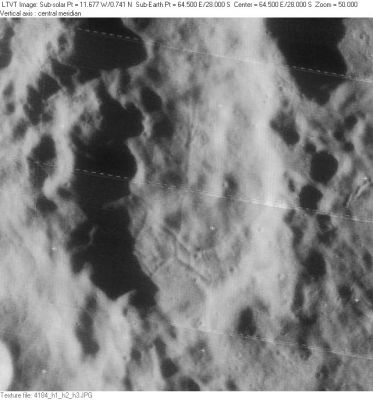Palitzsch
Contents
[hide]Palitzsch
|
Lat: 28.03°S, Long: 64.37°E, Diam: 41.87 km, Depth: 2.87 km, Rükl 59 |
LOIV-184-H2 Palitzsch is at the south end of the elongated trench known as Vallis Palitzsch. The boundary between the two does not seem to be clearly defined in the IAU nomenclature.
Images
LPOD Photo Gallery Lunar Orbiter Images Apollo Images
The location of the Concentric Crater near Legendre (which was included as item N°10 in C.A.Wood's list of 1978), should be immediately south of Palitzsch B (east of Palitzsch itself and northwest of Legendre). I have tried to detect this Concentric Crater on the Hi-Res scan of Lunar Orbiter 4's photograph LOIV-184-h2, alas... Perhaps there are much more detailed orbital photographs to discover (or to re-discover) the exact location of C.A.Wood's Concentric Crater "N°10".
Research: Danny Caes
Maps
(LAC zone 98C4) LAC map Geologic map
Description
Elger
(IAU Directions) PALITZSCH.--If this extraordinary formation is observed when the moon is about three days old, it resembles a great trough, or deep elongated gorge flanking the E. wall of Petavius, though it is a true ring-plain, albeit of a very abnormal type, about 60 miles in length and 20 miles in breadth, with a somewhat dusky interior. On the outer slope of its E. wall is a bright ring-plain with a lofty border and a central mountain.
Wikipedia
Additional Information
- IAU page: Palitzsch
- Depth data from Kurt Fisher database
- Westfall, 2000: 2.87 km
- Satellite crater Palitzsch B is on the ALPO list of bright ray craters and is mapped by the USGS as Copernican in age.
- Palitzsch B central peak height:
- Sekiguchi, 1972: 1.5 km - fatastronomer
- Concentric Crater south of Palitzsch B (?).
Nomenclature
- Named for Johann Georg Palitzsch (June 11, 1723 – February 21, 1788), a German astronomer. In December 1758 he observed the return of Comet Halley, as had been predicted by Edmond Halley in 1705.
- According to Whitaker (p. 218), this name was introduced by Schröter, who spelled it Palitsch.
LROC Articles
LPOD Articles
Bibliography
Named Features -- Prev: Palisa -- Next: Vallis Palitzsch
